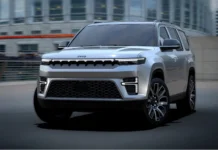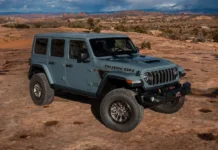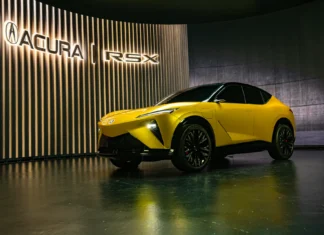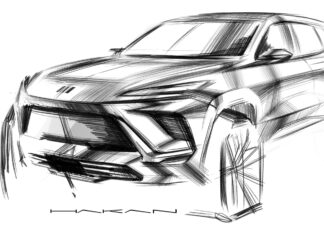
2020 Jeep Wrangler EcoDiesel Overview
| Pros | Cons |
| ✓ Still has that Jeep DNA | ☓ Eye-watering price tag |
| ✓ Rubicon is as capable as it gets out of the box | ☓ Diesel option is $4,000 more |
| ✓ Diesel option offers great low-down grunt | ☓ Hard to justify outside of very specific use cases |
| ✓ Good fuel economy (most of the time) and performance |
By now, the Jeep Wrangler JL is an all-too-common sight on the roads, especially around our home base in Colorado. Whether in two or four-door variants, from the base Sport up to this fully-loaded Rubicon, I saw about 5,000 other Jeeps that looked just like mine in my short time with this 2020 Jeep Wrangler. Despite that, I still felt special, and that’s all down to what’s under the hood. Now, you can buy a brand new Jeep Wrangler with FCA’s 3.0-liter EcoDiesel V-6 engine.
This 2020 Jeep Wrangler Rubicon EcoDiesel borrows its engine from the Ram 1500 pickup. It has the same 260 horsepower, as well as a large helping of torque, at 442 lb-ft. However, you are limited on which specific versions of the Wrangler you can equip with the EcoDiesel. At time of writing, you can only get it in four-door Unlimited models with the eight-speed automatic transmission.
At time of writing, a winter storm recently rolled through our neighborhood. What better way to test this Rubicon which, by the way, already blew me away with its eye-popping $64,380 price tag. Yeah, we now live in a world where a factory Jeep Wrangler costs well north of $60,000…
So, is it actually worth the cash? I took it into the foothills in a snowstorm to find out.

Can you live with the diesel?
Coming into this weekend, there was just something that doesn’t quite compute in my mind when you put together the concept of “Wrangler” and “diesel”. On paper, though, it should be a match made in heaven. You have all that low-down torque for slow-speed off-roading. On the other hand, you also have improved fuel economy over the old warhorse, the 3.6-liter Pentastar V-6. Fire it up, and you’ll be left in no doubt what you’ve bought thanks to the classic diesel clatter. FCA did work on making the engine quieter in this generation, and there’s more sound deadening so the loud noice doesn’t penetrate quite so easily into the cabin. That said, it still does sound more or less like a truck, especially when it’s cold.

Most of you won’t mind that, I know. TFL’s own Tommy Mica thinks the diesel is fantastically cool, and it’s all the better since you can actually hear it. That’s hard to argue, and I think I’d get used to the engine after a bit more time. Once it warms up, it’s actually pretty smooth and quiet as diesels go. Even better is that it is quick thanks to all that torque. It’s definitely no Pentastar, as I left my gas-powered cohorts in JLs and JKs behind at the lights. Now, this generation of VM Motori’s engine seems to be more refined than previous EcoDiesels, which have had their issues. I can’t speak to long-term reliability, but the diesel did feel like a solid powertrain as it left its first impressions. But then it should, considering it’s a whopping $4,000 over the base gasoline V-6.

It’s got it where it counts…off-road
That premium does pay dividends in terms of fuel economy, as we found out in real-world testing. That video is coming up, but the short version is that it does indeed meet (and exceed) its EPA fuel economy ratings on the highway. Driving around town, however, the fuel economy I experienced — about 20 mpg — was nothing spectacular.
So, if you make long highway trips to work or want a fuel efficient road trip machine, the EcoDiesel certainly passes muster in that department. Take note, if you do opt for the EcoDiesel, that the model has a smaller fuel tank than the Unlimited models with either the 3.6-liter Pentastar V-6 or the 2.0-liter turbo I-4. Whereas both those cars have a 21.5 gallon fuel tank, the EcoDiesel only has 18.3 gallons at its disposal, since you also have to consider the DEF (diesel exhaust fluid) tank.

But this is a Rubicon, the best of the best Jeep has to offer from the factory. Front and rear locking differentials, electronic sway bar disconnect, a true two-speed transfer case that you engage by pulling a proper lever. I’m not going to let the opportunity pass to test the 2020 Jeep Wrangler Rubicon EcoDiesel off the beaten track. Despite the recent 3-6 inch dusting of snow, what you can’t see in the pictures here is the trail still covered in ice. Yikes.

Staying warm and comfortable, and having fun
“Whatever,” I thought. “It’s a Rubicon, surely it can handle the snow”. And indeed it does. This top-dog Wrangler came equipped with a set of severe snow-rated BFGoodrich KO2s. We have a history with those tires here at TFL, and they performed no less admirably on the Wrangler Rubicon Ecodiesel than anything else we’ve had. What also came in useful, though, was the Jeep’s Off-Road Pages app. While you do get indicators in the digital part of the gauge cluster to tell you what everything’s doing, this provided a more comprehensive view. On the 8.4-inch Uconnect 4 display, you can see which of your differentials are locked, whether the sway bar is disconnected, your steering angle, altitude and even your GPS coordinates. Dig further, and you can also keep an eye on accessory gauges (like transmission temperature) and your pitch and roll when you’re going over tricky obstacles.
Add to that the optional Sky One-Touch power soft top, heated leather seats, automatic climate control and the cool looking LED light group, and I honestly came away from the experience wanting to buy this Wrangler. That said…

Verdict: It’s the perfect machine for a select few
I expected the 2020 Jeep Wrangler Rubicon EcoDiesel to be remarkable off-road, and it was. It’s also good around town if you don’t mind the diesel sounds, and it gets decent fuel economy. I came away with a similar attitude to the Toyota 4Runner, actually. As an everyday car, the Wrangler isn’t perfect. It does have loose-feeling steering and a firm ride thanks to higher spring rates to accommodate the heavier engine. But, as an indomitable force off-road and its characteristic Jeep charm, you can’t help but like the Wrangler.

Where my opinion differs from one of the Wrangler’s chief competitors is on price. On the TFL scale of “Buy It”, “Lease It”, “Rent It” or “Forget It”, the $64,380 price tag puts this firmly in the “Sorry, can’t even come close to affording it” category. Really, this specific combination is suited extremely well for the Forest Service, who could use the economy and the torque as well as the off-road capability.
Thankfully, everyone else has a host of options when speccing out a 2020 Jeep Wrangler. If off-roading is your passion, you still can’t go wrong with the Rubicon. The added torque from the diesel is a massive improvement over the Pentastar, but whether it’s worth $4,000 is ultimately up to you. At least in the U.S., diesel is more expensive than gasoline, and the fuel economy may not make up the extra up-front cost for a long while. Base model two-door Sports start at less than half this EcoDiesel’s MSRP, and everything from the power top to the LED lights and steel bumpers are extra-cost options that you can add or delete at your leisure.























